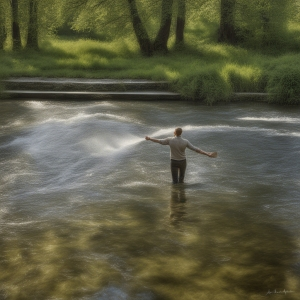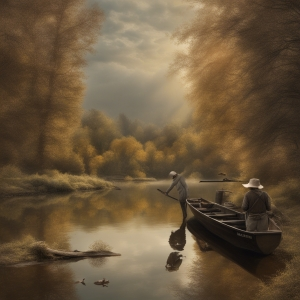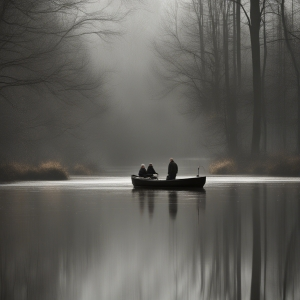Table of Contents:
From dawn's earliest light to the vibrant hues of a sunset, fishing provides some of the most stunning backdrops for photography. But capturing the thrill of the chase and the satisfaction of a successful catch can often seem as elusive as the wily fish themselves. This article, 'Fishing Photography Tips: Capturing Your Best Catches in Stunning Shots', aims to provide you with clear and actionable guidance to help you elevate your fishing photography from mere documentation to a powerful celebration of your experiences.
Introduction to Fishing Photography Tips
Whether you're an angling enthusiast looking to share your adventures with the world, or simply seeking to preserve personal memories against the ravages of time, good fishing photography is an essential skill. As with any form of outdoor photography, fishing pictures present their own unique set of challenges. With a little knowledge and practice, however, you can overcome these hurdles and produce truly memorable images.
The following fishing photography tips cover everything from gear recommendations to shooting techniques. They are tailored for beginner to intermediate photographers, but even seasoned pros may find insights here. With these tips in mind, you'll be well on your way to capturing radiant dawn landscapes, incredible action shots of fish leaping from the water, and everything in between.
So suit up, grab your camera, and let's dive into the exciting world of fishing photography.
Understanding the Basics of Photography
Before you start attempting to immortalize your angling exploits, it's essential to understand some fundamental principles of photography. These principles lay the groundwork for all the stages that follow.
First up is the rule of thirds. Imagine your photo is divided into a 3x3 grid. The idea is to align the subject of your photo along these lines or at the intersections. This technique helps to create a more balanced and engaging image.
Next, consider the exposure triangle - namely aperture, shutter speed, and ISO. Balancing these elements allows you to control the amount of light in your image and add artistic effects. For instance, a fast shutter speed can freeze the motion in high-speed action shots.
Finally, be aware of focus. For crisp, clear images, you need to ensure that your subject is in sharp focus. Depending on what you want to emphasis, you may choose to have a narrow focus (with only the subject in sharp detail) or a broader focus (where the entire scene is in sharp detail).
By mastering these basics, you're setting a solid foundation for capturing your best catches.
Pros and Cons of Fishing Photography Tips
| Pros | Cons |
|---|---|
| Preserving memories of your best catches | Requires carrying extra equipment |
| Creates stunning visuals for sharing online | Can be distracting from the actual fishing |
| Can help in documenting your fishing journey | May require specialized photography skills |
| Can be turned into a hobby or passion | Requires patience and understanding of light and positioning |
| Enhances the fishing experience | Can harm the fish if not done correctly |
Why Fishing Photography Matters

While fishing is first and foremost a personal pursuit, fishing photography opens the door to share that experience with the broader community. A stunning shot of a catch not only captures a moment of triumph, but it also conveys the essence of the sport – the patience, the anticipation, and the sheer joy of being in the great outdoors.
Moreover, fishing photography can play an important role in conservation. Your images can bring attention to the beauty and diversity of aquatic life and habitats, encouraging others to appreciate and protect our natural resources. Your photography might inspire the next generation of anglers, or even sway public opinion in favor of sustainable fishing practices.
In essence, fishing photography is about much more than showing off a lucky catch. It's about telling a story, spreading love for the sport, and advocating for the preservation of our waterways. Therefore, learning how to take great fishing-themed photos is not only rewarding on a personal level but also has wider implications for the sport and the environment.
Essential Equipment for Fishing Photography
As important as honing your photography skills is, having the right equipment makes a significant difference in the quality of your photos. So, here are the key pieces of equipment you'll want in your fishing photography toolkit:
Camera: You don't necessarily need a high-end DSLR to get great fishing shots, but a camera that allows for manual control of shutter speed, aperture, and ISO will give you the flexibility needed for various outdoor conditions.
Lenses: While the lens type you choose depends on the type of shots you prefer, a versatile zoom lens is always a safe bet. For those close-up shots of your prize catch or details of tackle, a macro lens is indispensable.
Tripod: A sturdy tripod is essential for keeping your shots steady, especially in low light conditions. Also, it is a must-have for those self-timer shots when reeling in a catch.
Weather Protection: Since a good deal of fishing occurs in waterside conditions, weather protection for your gear, like waterproof bags and cases, is crucial. This protection extends the life of your equipment and ensures you're always ready to capture that outstanding fishing moment, rain or shine.
Cleaning Supplies: Lastly, don’t forget the essentials for cleaning your gear. Dust, water spots, and grime can ruin a great shot. Keeping lens cloths, a brush, and air blower within reach ensures your gear is always in prime condition.
Investing in the right equipment and maintaining it well gives you an excellent starting point. Now, let's move on to putting that equipment to use with some shooting techniques.
Planning Your Fishing Photography Adventure

Before you hit the water, it's important to take some time for planning and preparation. To capture those awe-inspiring shots effectively, map out your fishing trip in advance. Consider the time of day, weather conditions, the species of fish you'll be targeting, and the location's overall aesthetic. Sunrise and sunset are particularly photogenic, offering diffused light and magical hues that can help elevate your photography to the next level.
Pay attention to the weather forecast not only to protect your equipment but also to plan for different lighting conditions. Bright, sunny days might be perfect for fishing but can lead to harsh shadows and overexposed photos. Overcast days, on the other hand, provide softer light that is more evenly distributed.
Researching your location can also be helpful. Try to visualize your compositions and think about different angles you could shoot from. Look up photos taken by other anglers or photographers to get an idea of what's possible and start brainstorming your own unique compositions.
Beyond preparation, remember that flexibility is key. No matter how much you plan, the reality of fishing is that there are a lot of unpredictable elements – from a sudden change in weather to the fish not biting. Stay adaptable to these changes and always be ready to capture the unexpected. The key is to experiment, have fun, and develop your distinctive fishing photography style over time.
Mastering the Art of Composition
Once you have a solid understanding of the basic principles of photography, the next step is to master the art of composition. This is where you decide what elements to include in your shot and where to place them. Effective composition elevates a catch snapshot into a compelling story that resonates with viewers.
Sense of Place: Be sure to give your catch some context. Include elements of the environment where you made your catch. This can be the soaring arch of a bridge, a softly lapping river, or a pile of tackle beside a worn pair of boots. These elements can provide a richer narrative to your catch and emphasize the sense of location.
Leading Lines: Utilize natural lines in your environment to guide the viewer's eye towards your catch. This could be a casting line, the edge of a boat, a horizon line, or the direction of sunlight. Using lines in this way adds depth and movement to the frame.
Angles and Perspective: Instead of always shooting from eye level, experiment with different perspectives. Get low for a dramatic ant's-eye view, or climb higher for a bird’s-eye overview of your set-up. Experimenting with angles can lend an entirely fresh view to your catch.
Use of Color: Pay attention to colors in your composition. The silver sheen of a fish might pop against a dark background, or the fiery colors of sunset might ring a magical aura to a scene. Good use of color can add emotion and mood to your photographs.
Remember, there's no absolute right or wrong in composition - it's an opportunity to let your creativity shine. The key is to take time to consider your shot rather than hastily clicking away. The effort you put into your composition will be evident in the quality of your photographs.
Fishing Photography In Different Weather Conditions

Weather plays a significant role in creating the mood and atmosphere of fishing photography. Here's how you can leverage various weather conditions for stunning shots:
Sunny Weather: Early morning or late afternoon, when the sunlight is softer, is ideal for fishing photography. Keep an eye on the shadows and try shooting with the sun behind you for the best results.
Cloudy Weather: Cloudy days offer soft, diffused light, ideal for close-ups of your prize catch. It's also perfect for capturing the colors and textures of the surrounding environment without harsh shadows.
Rainy Weather: Rain might dampen your spirits, but it can lend a unique, dramatic effect to your photos. Use water-repellent gear and shoot with a faster shutter speed to capture rain droplets mid-air.
Misty or Foggy Weather: These conditions can add a mysterious charm to the scene. Use manual focus to assure sharpness where you need it and keep in mind that colors may appear more muted and desaturated.
Whichever weather you find yourself in, remember that it's not just about the catch, but the entire experience of being at one with nature. Adapt to the conditions, experiment and you'll be rewarded with truly stand-out fishing shots.
Practical Tips for Capturing Stunning Shots
Now that we've covered the basic principles of photography and the key tools you should have in your gear kit, let's focus on some practical ways you can put these elements into practice to capture dazzling fishing shots.
Get creative with angles: Straight-on, eye-level shots are common, but don't be afraid to experiment with different perspectives. Try shooting from a higher vantage point to showcase the fishing landscape, or get down low for an intense, close-up shot of a catch.
Consider lighting conditions: Light is the heart of every photograph, so pay close attention to your surroundings. Early morning and late afternoon light, often referred to as the "golden hours," are particularly beautiful for fishing photography. But remember, lighting conditions change rapidly, so be prepared to adjust your camera's settings accordingly.
Capture the action: Fishing is filled with dramatic moments, be it casting off, reeling in a big catch, or the fish leaping out of water. Use a fast shutter speed to freeze these high-action moments in time and capture the energy and excitement of the sport.
Showcase the environment: Don't just focus on the catch; showcase the beauty of the environment. Whether it's a serene lake, a rushing stream, or a scenic coastline, the backdrop to your fishing adventure can add depth and context to your images.
Include human elements: While the fish are the stars of the show, including human elements - an angler's concentrated expression, hands skillfully handling the tackle, or weathered fishing gear beside a rustic boat - adds a personal touch and brings the story of your fishing trip to life.
Remember, the goal of your fishing photography isn't necessarily to get that 'perfect' shot (though the satisfaction when you do is unbeatable!). Rather, it's about capturing the essence of your angling adventures in a compelling and creative way. Follow these practical tips and watch your shots transform from simple fishing photos to full-fledged works of art.
Post-Processing Your Fishing Photos
Once you've clicked the shutter and celebrated your catch, you might think your job is done. However, often the magic truly comes alive in the post-processing stage. This is where you can turn a good photo into a stunning masterpiece.
Editing software: Programs like Adobe Lightroom or Photoshop are excellent tools for tweaking aspects such as exposure, contrast, color saturation, and cropping. Free options like Google's Snapseed or Canva can also do an excellent job when you're just starting out.
Adjusting exposure: Sometimes, nature refuses to play along, resulting in underexposed or overexposed photos. In these scenarios, editing software can help adjust the light, bringing back details hidden in the shadows or toning down overly bright parts.
Cropping and aligning: Crop your catch carefully and make use of the rule of thirds for a pleasing composition. Make sure the horizon line is straight to avoid a tilted look in your images.
Color correction: Boosting or toning down colors not only enhances your catch but also brings out the mood of the moment. Always remember to maintain a natural look and not overdo these adjustments.
Post-processing is far from cheating; it's a standard part of the photography pipeline. By learning to use these tools efficiently, you can produce images that truly capture the thrill of the catch and the beauty of the surroundings.
Conclusion
Having acquired a solid understanding of fishing photography principles, you are now equipped to embark on your own photo fishing adventure. The journey to capturing your best catches in stunning shots is one that goes beyond the satisfaction of landing a beautiful fish. It's an exploration of the natural world and an invitation to experience the incredible marvels it offers.
Remember to keep experimenting with different techniques and perspectives. The magic of fishing photography lies in its ability to capture both the tranquility and the excitement of the sport. As you work on your skills, don't forget the real value of these photos is in the stories they tell and the emotions they convey.
With continued practice and application of these tips, you'll soon be creating images that do justice to your great fishing expeditions. Images that invite viewers into your world and inspire them to experience the same joy you find in fishing. So pick up your camera and start telling your story, one catch at a time.
FAQ zum Thema Erfolgreiche Fischfotografie
Was sind die Grundlagen der Fischfotografie?
Die Grundlagen der Fischfotografie beinhalten die Wahl des richtigen Equipments, die Beherrschung von Beleuchtung und Komposition, das Einfangen der Details und Action von Fischen und die richtige Nachbearbeitung der Fotos.
Welche Ausrüstung benötige ich für die Fischfotografie?
Für die Fischfotografie benötigt man eine gute Kamera, ein robustes Stativ, verschiedene Objektive für verschiedene Perspektiven und Szenen, und eventuell auch spezielle Ausrüstung wie Unterwassergehäuse.
Wie verbessere ich meine Fähigkeiten in der Fischfotografie?
Die Verbesserung der Fischfotografie kann durch ständige Übung, das Studium anderer Fotografien, den Besuch von Workshops oder Kursen, das Erlernen neuer Techniken und Experimentieren erreicht werden.
Wie bearbeite ich meine Fischfotos nach?
Die Nachbearbeitung von Fischfotos kann mit Hilfe von Fotobearbeitungssoftware wie Adobe Photoshop oder Lightroom geschehen. Man kann Helligkeit und Kontrast anpassen, Farben korrigieren, Details schärfen und unerwünschte Elemente entfernen.
Wie stelle ich die Action und Dynamik von Fischen in meinen Fotos dar?
Um die Action und Dynamik von Fischen in den Fotos darzustellen, kann man Techniken wie Panning, Burst-Modus und schnelle Verschlusszeiten verwenden. Auch die Wahl des richtigen Moments und des richtigen Blickwinkels spielen eine wesentliche Rolle.







